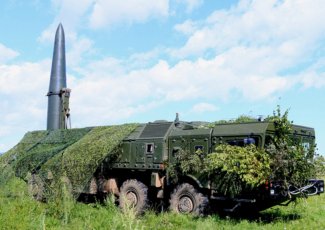Russia threatens to use tactical nuclear weapons. Day 803 of the war


Russian forces in Donetsk oblast drove the remnants of the defenders out from the outskirts of Ocheretyne and seized Arkhanhelske, which lies north-east of that town. They also expanded the area under their control to the north-west and south of Ocheretyne; however, the pace of their advance slowed as Ukrainian reserves were drawn into the battle area. The invaders made further advances in the centre of Krasnohorivka and west of Marinka, entering the central part of neighbouring Heorhiivka, as well as south of Marinka. After days of fighting, the Russians occupied the forest south of Chasiv Yar and fortified themselves on the eastern bank of the Donets-Donbas canal. Despite repeated assaults, they still failed to penetrate into the Kanal microdistrict to any great depth. Kyiv estimates the size of the grouping attacking Chasiv Yar at between 20,000 and 25,000 troops.
After the Russian assault resumed the previous week, their troops pushed the Ukrainian defenders out of Kotliarivka and Kyslivka south-east of Kupyansk. Fighting for these villages had continued intermittently since last autumn. They constituted a Ukrainian bastion between the railway line and the P07 highway leading from Kharkiv via Kupyansk to the Russian border. The Russian forces’ subsequent actions, particularly the strike on Ivanivka which lies to the north of the aforementioned villages, indicate that they do not intend to capitalise on their success to launch a direct assault on Kupyansk, and are concentrating on eliminating further local points of Ukrainian resistance. Following the resumption of fighting south of Velyka Novosilka, the invaders entered Urozhayne, the last village in the area which the Ukrainians recaptured as part of the 2023 summer offensive. The Russians succeeded in seizing its southern part and the areas to the east of it. The defenders prevented Russian forces from taking full control of the village of Robotyne south of Orikhiv, holding on to its northern and eastern outskirts.
On 1 May, restrictions on the movement of people and the performance of work not related to the construction and maintenance of engineering and fortification facilities, including agricultural work, were introduced in 15 municipalities in Sumy oblast close to the Russian border. The ban has come in response to the deteriorating security situation: Sumy oblast is regularly being shelled and attacked by Russian reconnaissance and diversionary groups.
On 2 May, in an interview with the Economist, the deputy head of Ukrainian military intelligence Vadym Skibitsky admitted that Russia could launch attacks on Sumy and Kharkiv in late May or early June. However, he stated that this depended on the condition of the Ukrainian defences, and that Russian forces would not be able to occupy Kharkiv or Sumy cities. According to him, at present the Russians are maintaining around 35,000 troops in the border area around the first of these cities, and plan to concentrate a total of up to 50,000–70,000 men there. Referring to the possibility of ending the conflict, Skibitsky admitted that he sees no real chance of Ukraine winning the confrontation with Russia “on the battlefield alone”, and that the recovery of the occupied territories “is becoming an increasingly distant prospect”, which would not end the war anyway. In his view “such wars can only end with a treaty”, but no such potential talks could begin before the second half of 2025, by when Russia should be facing serious difficulties. He warned that if the countries supporting Ukraine do not find ways to increase defence production to help Kyiv, they too could face a military threat.
On 3 May, the commander of the Ukrainian Land Forces, Oleksandr Pavliuk, said in the Times of London that there are more than 510,000 Russian troops in the temporarily occupied territories. According to him, their number could increase by another 100,000 during the year as Russia prepares to launch offensive operations in June and July. He added that by the end of this year Russian could mobilise a further 300,000 men. Pavliuk, citing information from the Ukrainian special services, admitted that the Russians had drawn up a plan to seize Kharkiv or Sumy.

The Russians intensified their attacks on targets in the border regions of Kharkiv and Sumy, systematically destroying energy infrastructure, railways and warehouses. From 1 to 6 May, the city of Kharkiv was attacked daily with rockets, kamikaze drones and guided aerial bombs; the city was struck on five occasions on 4 May alone. The junction town of Chuhuyev was also one of the main targets in Kharkiv oblast (the railway station was hit on 3 May). On 6 May, a massive attack by Shaheds on the energy infrastructure led to parts of Sumy oblast losing electrical power (a high-voltage substation was among the structures destroyed), and its most important institutions had to switch to emergency power. A total of 400,000 subscribers lost power in the region, which just before the war had a population of just over 1 million (there is no public information on how many remain). On 4 May, kamikaze drones also damaged a high-voltage substation in the Pavlohrad region of Dnepropetrovsk oblast, and a day later 300-mm rocket shells damaged a thermal power plant near Slavyansk.
On 1 May, Odesa was attacked twice, and the evening strike resulted in one of the largest fires since the beginning of the war. The missiles almost certainly hit ammunition depots (according to some Ukrainian sources, Storm Shadow cruise missiles were stored there) and the headquarters of the Operational Command ‘South’. The city was attacked again on 4 May. Russian missiles also struck the Kryvyi Rih (2 May), Kropyvnytskyi (3 May) and Poltava (5 May) oblasts. In total, from the evening of 30 April to the morning of 7 May, the invaders used 30 missiles (mainly from S-300 and Iskander systems), of which the defenders claimed to have shot down two or three. In the Shahed drone attacks carried out on 4–6 May, the Russians, used 50 drones of which, according to the Ukrainian Air Force Command, only two hit their targets (the local military administrations reported an even lower rate of effectiveness).

On 6 May, the Russian defence ministry announced that it had begun preparations for an exercise using ‘non-strategic nuclear forces’ to enhance their readiness for combat tasks. This will envisage practising the preparation and use of tactical nuclear weapons (TNW). The ‘tactical missile compounds’ (missile brigades equipped with Iskander systems) of the Southern Military District will participate in the exercise, with the support of the aviation and the Russian Navy. The tests are intended as a response to “the provocative statements and threats against Russia made by selected Western officials”. Ukrainian military intelligence said that nuclear blackmail is a regular practice of the Putin regime, and that it has not observed anything new other than increased media & propaganda activity.
Unlike the Strategic Nuclear Forces Exercises, which were last held in Russia under the code name ‘Grom’ in 2022, the use of TNWs in training has not been publicised by Moscow. There have been sporadic media leaks suggesting the use of TNWs in scenarios for other exercises (such as Zapad-2017).
If these exercises do indeed take place, it remains unclear whether (as suggested by the Russian defence ministry) the tactical nuclear warheads will actually be relocated from storage and deployed in designated units of the Southern Military District, of which Russia considers the Ukrainian territory it has occupied to be an administrative part (systems capable of carrying TNWs have been deployed in Crimea). Carrying out this type of exercise in areas directly threatened by Ukrainian attacks, especially in a situation where responsibility for nuclear warheads is ceded to a relatively low command level (such as the army or corps command of the Russian Land Forces), could result in them coming under Ukrainian fire, with consequences which would be difficult to define. In this context, the announcement of the exercises should be seen as another threat directed at the West, an element of psychological warfare intended to escalate the conflict.

On 30 April, the Ukrainian foreign ministry clarified that the decision to suspend consular services for Ukrainian citizens residing abroad applies only to men of conscription age, and is intended to bring a temporary halt to the receipt of applications. Men who have updated their data as required by law (that is, who have confirmed their registration at the military commission) will be able to submit applications for consular services, obtain a place in the e-queue and make appointments at the consulate. It was stressed that the suspension of services does not apply to cases of emergency consular assistance. The defence ministry has insisted that no draft cards will be handed out when men register at the military commissions.
More funding for drones has been announced. On 30 April, Prime Minister Denys Shmyhal announced the allocation of an additional 15.5 billion hryvnias (c. $400 million) for the purchase of drones. This year, 43.3 billion hryvnias (c. $1.1 billion) have been allocated for the purchase of drones.

In the first days of May, Ukrainian kamikaze drones once again struck fuel and energy infrastructure on Russian territory. On 1 May facilities in Ryazan, Rostov-on-Don and Voronezh were attacked. The only confirmed result of the attack was a fire at a refinery site in Ryazan. The following day five Russian regions were attacked. Damage to the power grid occurred in the Kursk and Oryol oblasts. In Krasnodar krai, drones were neutralised in the Afipskaya refinery area, while in the Rostov and Smolensk oblasts the drones were neutralised before reaching their target. On 6 May, Ukrainian surface drones attacked Chornomorske on the Tarkhankut peninsula in the western part of Crimea. Some of them hit the boom, allowing through one drone which sank a patrol boat standing by the jetty. Russian sources expect a large Ukrainian strike (most likely on Crimea) on the occasion of Victory Day celebrations on 9 May.

Reports in the US press are toning down the optimism surrounding the $61 billion financial support recently granted to Ukraine. According to the New York Times on 3 May, the Ukrainian army has received two batches of the most essential 155-mm artillery shells and anti-tank missiles, mostly from US stocks, while the rest of the armaments and ammunition announced will be transferred to Ukraine gradually over a longer time horizon. The first pieces of heavy weaponry from the military aid package announced on 24 April are expected to arrive in Ukraine “in early summer or later”. On 6 May, the Spanish defence minister Margarita Robles confirmed the arrival in Ukraine of missiles for Patriot systems from the stockpiles of the Spanish army “and other allies”. On 30 April, the Lithuanian government approved a new military aid package, the main part of which are 35-mm NBS MANTIS anti-aircraft guns and reconnaissance drones. On 2 May, the Ukrainian flag was raised on two patrol boats donated by Estonia, the Irpin (formerly the P01 Roland) and the Reni (formerly the P02 Risto).
On 6 May Mykhailo Fedorov, the Ukrainian deputy prime minister for innovation, education development, science and technology, announced after a meeting with the Polish minister for digitalisation Krzysztof Gawkowski, that the Polish government would continue to pay for the operation of the more than 20,000 Starlink terminals that Warsaw had given to Ukraine. These have become part of the critical infrastructure providing internet access to Ukraine. In addition, Poland will extend the licence fee for these terminals.





